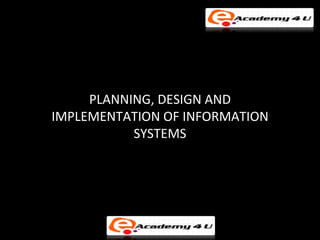
Planning, design and implementation of information systems
- 1. PLANNING, DESIGN AND IMPLEMENTATION OF INFORMATION SYSTEMS
- 2. STAGES/PHASES IN SDLC SYSTEMS INVESTIGATION – PHASE 1 - Include preliminary study of proposed IS solutions to meet a company’s e-business priorities & opportunities. - Investigation stage: a. determine how to address e-business opportunities. b. conducting feasibility study. c. develop project management plan & obtain management approval.
- 3. SYSTEM INVESTIGATION : PHASE 1 • FEASIBILITY STUDY 1. Organizational feasibility Focuses on how well a proposed system supports the e- business priorities of the organization. 3. Economic feasibility Focuses on whether expected cost savings, increased revenue, increased profits, and reductions in required investment, will exceed the costs of developing and operating a proposed system.
- 4. SYSTEM INVESTIGATION : PHASE 1 3. Technical feasibility Focus on the reliabilities/capabilities of the hardware and software to meet the needs of the proposed system. 4. Operational feasibility Focus on the willingness and ability of the management, employees, customers, suppliers, and others to operate, use, and support the proposed system. 5. Schedule feasibility Focus on the solution be designed & implemented within an acceptable time period.
- 5. SYSTEM ANALYSIS : PHASE 2 - Systems analysis is an in-depth study of end user information needs, which produces functional requirements that are used as the basis for the design of a new information system. - Types of analysis: 1. Organizational Analysis involves evaluating the organizational and environmental systems and subsystems involved in any situation. 2. Analysis of the Present Systems involves analyzing activities, resources (hardware/software/people), and the products.
- 6. SYSTEM ANALYSIS : PHASE 2 1. Functional Requirement Analysis Determine the information processing capabilities required for each system activity (input, processing, output, storage, and control) to meet the information needs.
- 7. SYSTEM DESIGN: PHASE 3 1. USER INTERFACE DESIGN Focuses on supporting the interactions between end users and their computer-based applications – EG: display screens, interactive user/computer dialogues, audio responses, forms, documents, and reports. 2. DATA DESIGN - Physical View – the design shows how the database is arranged, stored and accessed on the storage devices of a computer system. - Logical View – conceptual design within an abstract model. Data elements and relationship are used in the model. 3. PROCESS DESIGN
- 8. SYSTEM IMPLEMENTATION: PHASE 4 The activity includes: • Acquisition of hardware, software and services. • Software development or modification. • Testing of programs, procedures, and hardware. • System documentation. • Conversion (parallel, pilot, phased, plunge). • End User training.
- 9. SYSTEM IMPLEMENTATION: PHASE 4 CONVERSION METHODS • Parallel Conversion: - Both the old and the new system are operated until the project development team and end user management agrees to switch completely over to the new system. • Phased Conversion: - Only parts of a new application or only a few departments, branch offices, or plant locations at a time are converted. A phased conversion allows a gradual implementation process to take place within an organization. • Pilot Conversion: - Where one department or other work site serves as a test site. A new system can be tried out at this site until developers feel it can be implemented throughout the organization. • Plunge/Direct Cutover: - Use the system immediately and totally abandons the old system.
- 11. SYSTEM MAINTENANCE / EVALUATION: PHASE 5 System Maintenance System maintenance is the monitoring, evaluating, and modifying of operational e-business systems to make desirable or necessary improvements. System Evaluation Evaluate or judge the performance of a system over a longer time period than that just after immediate installation.
- 12. SYSTEM MAINTENANCE / EVALUATION: PHASE 5 FOUR (4) PROBLEM AREAS CONTRIBUTE TO SYSTEM FAILURE 3. DESIGN - System fail to capture essentials business requirements. - Poor format of the system – eg: represent wrong piece of data. - poor user interface – not user friendly. Hard to use by the user. 7. COST - Cost to implement may be over budget. - System project may be too costly to complete.
- 13. SYSTEM MAINTENANCE / EVALUATION: PHASE 5 FOUR (4) PROBLEM AREAS CONTRIBUTE TO SYSTEM FAILURE 3. Data - Data inaccurate or inconsistent and not properly organised. - Information in certain fields may be erroneous or ambiguous. - Data incomplete – information may be inaccessible. 4. Operation - System does not run well. - Information is not available in a timely & efficient manner because computer breakdown. - Response time may too long.
- 14. ALTERNATIVE TO THE SDLC PROTOTYPING Prototyping is the rapid development and testing of working models, or prototypes, of new applications in an interactive, iterative process involving both IS specialists and business professionals. Tools for prototyping • Screen generators (screen painters) • Graphics • Report generators (report writers)
- 15. ALTERNATIVE TO THE SDLC Categories of Prototypes 2. Non-working prototypes 3. Partially working prototypes. 4. Pilot prototypes 5. Staged prototypes
- 16. Four Steps in the Prototyping Process • Identify the user’s basic requirements – the system designer works with the user to capture the user’s basic information needs. • Develop an initial prototype – the system designer creates a working prototype quickly, using tools for rapidly generating software. • Use the prototype – the user is encouraged, to work with the system to determine how well the prototype meets the requirement and make suggestions for improving the prototype. • Revise and enhance the prototype – System builder notes all changes the user requests and refines the prototype accordingly.
- 17. Advantages of Using Prototyping • Prototyping makes the development process faster and easier for IS specialists and business professionals. • Prototyping involve end-user development throughout the systems development life cycle.
